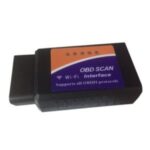The OBD2 port on a 2003 Chevy Tahoe is essential for diagnosing engine problems. However, a non-functional port can be frustrating. This guide will help you locate the OBD2 port and troubleshoot common power issues that may prevent it from working correctly. We’ll focus on Fuse 13, a common culprit in OBD2 and cigarette lighter power failures.
Locating the OBD2 Port and Understanding the Circuit
The OBD2 port in a 2003 Chevy Tahoe is typically located under the driver’s side dashboard, near the steering column. It’s a trapezoidal-shaped connector with 16 pins.
The power supply for both the OBD2 port and the cigarette lighter runs through Fuse 13 in the underhood fuse box. This simple circuit connects directly from the load side of Fuse 13 to pin 16 of the OBD2 connector and the center terminal (Pin A) of the cigarette lighter. Understanding this connection is crucial for effective troubleshooting.
Troubleshooting Steps: No Power at OBD2 Port
If your OBD2 port isn’t working, the cigarette lighter might also be malfunctioning. Here’s a step-by-step guide to diagnose and fix the problem:
1. Check and Replace Fuse 13:
- Even if Fuse 13 looks intact, replace it with a known good 20 Amp fuse. Fuses can fail without visible damage. Dirty or oxidized terminals on the fuse can also cause problems.
2. Verify Power After Fuse Replacement:
- After replacing Fuse 13, check if the OBD2 port is now active. You can use a multimeter to check for 12 VDC at the cigarette lighter.
3. Test for Voltage at Fuse 13:
- If the problem persists, use a multimeter (DC volts setting) to check for 12 VDC on both sides of Fuse 13. Ground the negative lead and touch the positive probe to each exposed pin of the fuse.
4. Check for Continuity:
- If you don’t find 12 VDC on both sides of Fuse 13, switch your multimeter to ohms. Connect one lead to the load side of Fuse 13 and the other to pin 16 of the OBD2 port. A reading of zero ohms indicates a good connection. A higher reading suggests a wiring issue between the fuse box and the OBD2 port.
5. Trace Wiring (if necessary):
- If continuity testing reveals a problem, you’ll need to visually inspect and potentially trace the wiring between the fuse block and the OBD2 connector to identify any breaks or damage.
Conclusion
A non-functioning OBD2 port can often be traced back to a faulty Fuse 13 or a wiring issue in the circuit. By following these troubleshooting steps, you can often quickly resolve the problem and get your OBD2 scanner working again. If you continue to experience issues, consult a qualified automotive technician for further diagnosis and repair.
